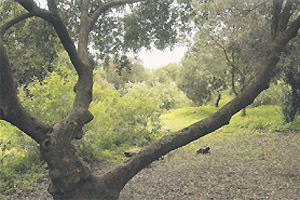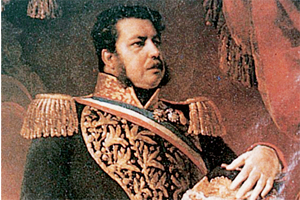In the Metropolitan Region there is a warm template climate with winter rainfalls distinguishing two sub types: one with a long dry season of 7 to 8 months and another with a dry season of 4 to 5 months. Next, we shall chiefly describe this climatic sub types:
– Warm template climate with winter rainfalls and a long dry season: this is determined because the Coastal Ranges do no allow the influence of the Ocean and because the produced thermal inversion diminishes the precipitations in those sectors nearby its western foothill. This produces, for example, that at the Colina sector may be given arid climates and with more thermal fluctuations, which reflexes in the penetration of the steppe climate.
Rains are irregular (one rainy year and another dry one) and fall, especially, during the months of May, June, July an August.
In Santiago, the annual average of fallen water is of 369, 5 mm and its annual average temperature is of 14°C, but, during summer, the maximums reach values superior to 30°C during the day.
– Warm template climate with a dry season of 4 to 5 months: known also as landlocked climate with a brief dry season, it is developed in the Andean zones (above the 3.000masl). Here, the Andes Ranges produce a contrary effect to the one from the Coastal Ranges, augmenting precipitations as it ascends. The rain period is long (it reaches the 80% of yearly fallen water) and there are only four or five months of dry period. In some places, precipitations are solid, for which reason it accumulates in snow and permanent ice fields at the summits and in the high ranges creeks (above the 1.500 masl)). Here, outstands glaciers such as Marmolejo and Plomo
Besides, the thermal oscillations are great registering a temperature almost 32°C of difference between the warmest month, that is January, and the coldest, which is July, with temperatures that may be inferior to 0°C.
Hydrography
The hydrographic net is represented mainly by the Maipo river and its main affluent rivers are: Mapocho, El Yeso and Colorado. In general terms, these are characterized for been torrent due to its´ relief inclination.
– Maipo river: it drifts for 250 kilometers and has a basin draining 15.380 km2. Its´ average flow is 92, 3 m3/s and has a mixed origin since its waters come from winter precipitations and snow thawing. Is born at the Andes Ranges specifically at the Maipo volcano’s foothills and in the confluence of the Cruz de Piedra, Alvarado and Arguelles rivers, In its first part encounters three of its tributaries, the Colorado volcano and El Yeso river. Then, northwards the Santiago’s basin, flows into the Mapocho river. In its middle and inferior course receives other affluent rivers, such as the Clarillo and Angostura and the Puangue creek (originated in the Coastal ranges), Finally, the Maipo river empties in the Pacific Ocean near the Llolleo location (Region of Valparaiso).
– Mapocho river: is born at the Andes Ranges (El Plomo sector), specifically at the junction of the Molina and San Francisco rivers. The Mapocho drains waters from winter rains and during summer is nurtured by the snow thawing of the high summits, Finally, after drifting 110 km-where receives waters of the following creeks; Yerba Loca, El Arrayán and Lampa and from the San Carlos channel-flows into the Rio Maipo.
– Rio El Yeso: drains the high range and its two affluent are born, one at the northern foothill of the Cerro Marmolejo and the other at the southern foothill of the Piuquenes hill. El Yeso, in its superior course is dammed, becoming the main water reservoir for the Metropolitan Region. Farther below flows in the Rio Maipo.
– Colorado river: is born at the foothills of the Las Polleras and Tupungato hills (at the border with Argentina) and in the Olivares river. The Colorado is southwestbound and flows into the Rio Maipo. Regarding the lacustrine type hydrographic systems, stands of the Aculeo and Rapel lagoons
Biogeography
The Metropolitan Region’s biogeography is one of the country’s most altered due to the fact that the majority of its natural spaces has been occupied by urban settlements or for agricultural usage.
As a fact, the MR fauna is scarcer, compared with other regions, besides, it presents the country’s highest rate of species vulnerability. In other words, is the region where more rapidly and in higher quantities flora and fauna are been reduced.
Besides, there is a great quantity of introduced species, most of which are considered plagues, such is the case of the Rabbit (Oryctolagus cuniculus), the Hare (Lepus capensis), the African Frog (Xenopus laevis) the Yellow Jacket Bee (Vespula germanica), among others.
In this region, can be noticed three phytogeographic units, which we shall describe as it follows including, besides, the most important aspects of its fauna.
– The Chacabuco mountain range southern slope and the valleys in the northern part: in this zone predominates the scraggly spiny forest, which is compound by high bushes and spiny trees that are distributed in open spaces with abundant herbs. In this zone, the prevailing specie is the Hawthorn (Acacia caverns), which have as companions species as the Holy Wood (Porlieria chilensis), the Carob Tree (Prosopis chilensis), the Huañil (Proustia cuneifolia) and the Maiten (Maytenus boaria), among others.
Regarding the fauna, it is mainly constituted by birds such as the Rayadito (Aphrastura spinicauda), the Tench (Mimus thenca), the Yal (Phrygilus fruticeti), the Loica (Sturnella loyca), the Burrowing Owl (Athene cuniculinaria), the Kestrel (Falco sparverius), and the Peuco (Parabuteo unicinctus). Also there are some species of rodent mammals such as the Olive-Colored Small Mouse (Abrothrix olivaceus), the Big-Eared Mouse (Phillotis darwini) the Brush-Tailed Mouse (Octodon degus) and the Cururo (Spacalopus cyanus).
– Pre Andean ranges sector: in this environment is present the pre Andean ranges esclerofic forest which is a formation found at the slopes of the low foothills of the Andes Ranges. It is determined not only by height, but also, for the sun exposure. Among the prevailing vegetable species are. The Litre (Lithraea caustica), the Quillai (Quillaza saponaria), the Peumo (Cryptocarya alba), the Colliguay (Colliguaja odorifera), the Hawthorn (Acacia cavens), the Lingue (Persea lingue), the Chequén (Luma chequen), the Chagual (Puya berteroniana), the Maitén (Maytenus boaria), the Maqui (Aristotelia chilensis), the Canelo (Drimys winteri) among others.
In this environment, the prevailing fauna includes mammals such as the Big-Eared Bat (Histiotus mantanus), the Hawthorn Long-Tailed Mouse (Oligoryzomys longicaudatus), the Viscachas (Lagidium viscacia) and the Patagonian Fox and the Argentine Grey Fox (Pseudalopex culpaeus and P. griseus). Among the birds are the following: the Andes Ranges Tórtola (pidgeon) (Metriopelia melanoptera), the Condor (Vultur gryphus), the Harrier (Buteo polyosoma), the Goldfinch (Carduelis uropygialis), the Minero ( Geositta cunicularia), etc.
– Coastal Ranges: at the summits and slopes of this ranges develop small isolated forests, that form what is called Santiago´s decidous forests.This if compound by some of the following species: the Oak tree (Nothofagus oblique), the Peumo (Cryptocarya alba) the Olivillo (Kageneckia angustifolia), the Duraznillo (Colliguaja integerrima) and the Wild Walnut (Lomatia hirsute) and others.
In the Coastal ranges slopes and under the Santiago´s decidous forest there is a spiny bushy formation that shelter species such as: the Boldo (Peumus boldus), the Colliguay (Colliguaja odorifera), the Litre ( Lithraea caustica), the Espino (Acacia cavens), the Quillay (Quillaja saponaria), the Huañil ( Proustia cuneiffolia), among others.
In this ambiences the fauna that can be observed are the birds, standing out the Diuca ( Diuca diuca), the Yal (Phrygilus fruticeti), the Thrush (Curaeus curaeus), the Loica (Sturnella loyca), the Chesy hesy (Zonotrichia capensis), the Chirihue (Sicales luteo), the Thrush (Turdus falklandii), etc.








